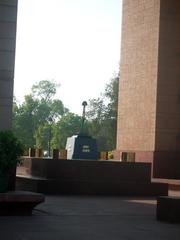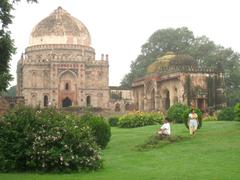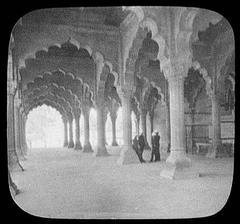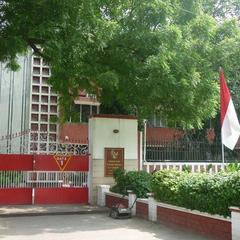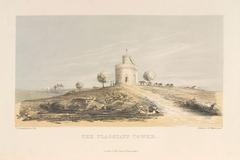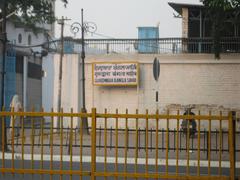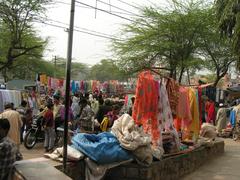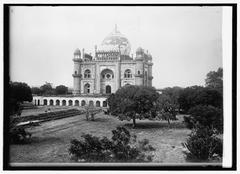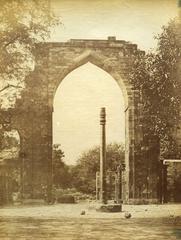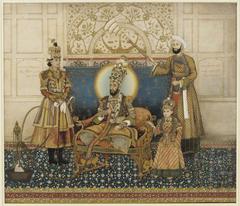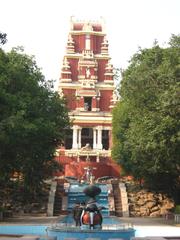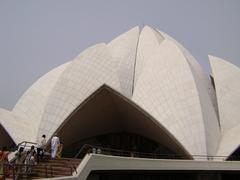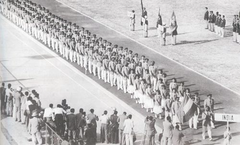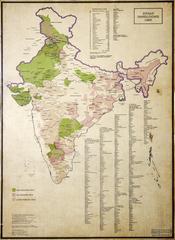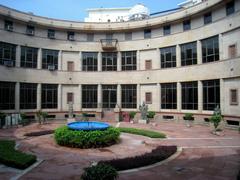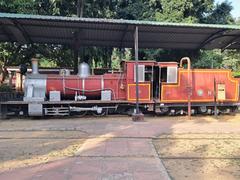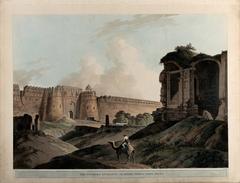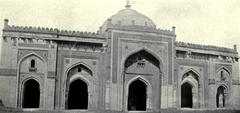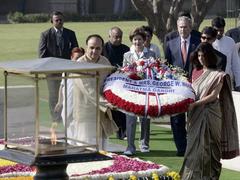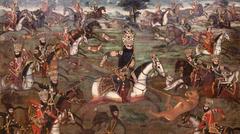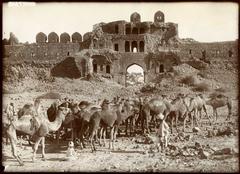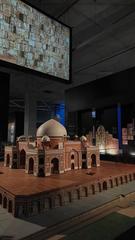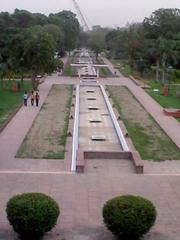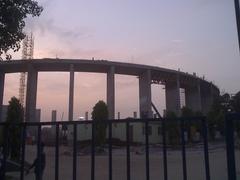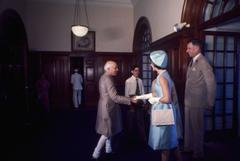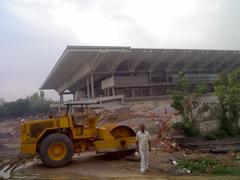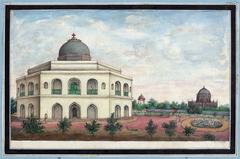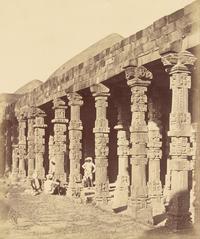Guide to Visiting Mumtaz Mahal, New Delhi, India
Publication Date: 19/07/2024
Introduction
Mumtaz Mahal, an architectural marvel housed within the Red Fort complex in New Delhi, India, is a testament to the grandeur of Mughal architecture and the rich cultural heritage of the era. Commissioned by Emperor Shah Jahan in the mid-17th century, the Red Fort served as the main residence of Mughal emperors for nearly two centuries. Mumtaz Mahal, named in honor of Shah Jahan’s beloved wife, showcases the intricate craftsmanship and artistic prowess of the Mughal artisans (Britannica). This guide aims to provide an in-depth exploration of Mumtaz Mahal’s historical significance, architectural brilliance, and visitor information to help you plan a memorable visit. From detailed descriptions of the palace’s floral motifs and marble inlays to practical tips on visiting hours, ticket prices, and nearby attractions, this comprehensive guide covers all aspects of experiencing the beauty and history of Mumtaz Mahal (UNESCO).
Table of Contents
- Exploring Mumtaz Mahal - History, Visiting Hours, and Tickets in New Delhi
- Ultimate Guide to Visiting Mumtaz Mahal, New Delhi - Hours, Tickets, and Tips
- Introduction
- Brief History and Cultural Significance
- Location and Accessibility
- Opening Hours and Best Time to Visit
- Entry Fees and Tickets
- Guided Tours and Audio Guides
- Photography and Videography
- Dress Code and Etiquette
- Facilities and Amenities
- Safety and Security
- Accessibility for Disabled Visitors
- Nearby Attractions
- Tips for a Memorable Visit
- Frequently Asked Questions (FAQ)
- Visit and Stay Up to Date
Exploring Mumtaz Mahal - History, Visiting Hours, and Tickets in New Delhi
Historical Background
Mumtaz Mahal, located within the Red Fort complex in New Delhi, India, is a significant historical structure that dates back to the Mughal era. The Red Fort itself was commissioned by Emperor Shah Jahan in 1638 and completed in 1648. The fort served as the main residence of the Mughal emperors for nearly 200 years, until the British colonial period. Mumtaz Mahal, named after Shah Jahan’s beloved wife Mumtaz Mahal, was originally part of the imperial harem and served as a private residence for the royal women.
Architectural Design
Mughal Architecture
Mumtaz Mahal is a quintessential example of Mughal architecture, which is characterized by its intricate designs, symmetry, and use of red sandstone and marble. The structure showcases the blend of Persian, Timurid, and Indian architectural styles, which were prevalent during the Mughal era. The use of white marble in the interior and red sandstone in the exterior is a hallmark of Shah Jahan’s architectural style, also seen in other monuments like the Taj Mahal and the Jama Masjid.
Layout and Structure
The layout of Mumtaz Mahal is a reflection of the Mughal architectural principles of symmetry and balance. The building is part of a larger complex that includes several other palaces and structures within the Red Fort. The Mahal itself is divided into six apartments, each adorned with intricate floral designs and marble inlays. The central hall, known as the Diwan-i-Khas, was used for private audiences and is one of the most elaborately decorated parts of the Mahal.
Decorative Elements
Floral Motifs and Inlays
One of the most striking features of Mumtaz Mahal is its decorative elements, particularly the floral motifs and marble inlays. These designs are not merely ornamental but also hold symbolic meanings, often representing paradise as described in Islamic texts. The use of semi-precious stones like lapis lazuli, turquoise, and jade to create intricate inlays is a testament to the craftsmanship of the artisans of that era.
Calligraphy
Another significant decorative element is the use of calligraphy, which adorns the walls and ceilings of Mumtaz Mahal. The calligraphy often includes verses from the Quran, adding a spiritual dimension to the aesthetic beauty of the structure. This practice of incorporating calligraphy into architectural designs was a common feature in Mughal architecture and can also be seen in other monuments like the Taj Mahal and the Qutub Minar.
Cultural Significance
Role in Mughal Court Life
Mumtaz Mahal played a crucial role in the daily life of the Mughal court. As part of the imperial harem, it was a private space for the royal women, who played significant roles in the political and cultural life of the empire. The Mahal was not just a residence but also a place where important decisions were made, and cultural activities like poetry recitals and musical performances took place.
Influence on Later Architecture
The architectural style and decorative elements of Mumtaz Mahal have had a lasting influence on later architectural developments in India. The blend of Persian and Indian styles seen in the Mahal set a precedent for future constructions during the Mughal era and beyond. Even during the British colonial period, elements of Mughal architecture were incorporated into new buildings, showcasing the enduring legacy of structures like Mumtaz Mahal.
Preservation and Restoration
Challenges
Preserving a historical structure like Mumtaz Mahal comes with its own set of challenges. The building has suffered from the ravages of time, pollution, and neglect, particularly during the British colonial period when parts of the Red Fort complex were used as military barracks. Efforts to restore and preserve the Mahal have been ongoing, but they require significant resources and expertise.
Restoration Efforts
Several restoration projects have been undertaken to preserve the architectural and historical integrity of Mumtaz Mahal. These efforts often involve meticulous work to restore the intricate inlays and floral designs, as well as structural repairs to ensure the building’s stability. Organizations like the Archaeological Survey of India (ASI) have been at the forefront of these restoration efforts, employing both traditional techniques and modern technology to achieve their goals (ASI).
Mumtaz Mahal Visiting Hours and Visitor Experience
Visiting Hours and Tickets
Mumtaz Mahal is open to visitors as part of the Red Fort complex. The general visiting hours are from 9:30 AM to 4:30 PM, Tuesday to Sunday. The fort is closed on Mondays. Ticket prices for Indian citizens are INR 35, while for foreign tourists, the entry fee is INR 550. Children under the age of 15 can enter for free. Tickets can be purchased online or at the entrance.
Accessibility
Mumtaz Mahal is accessible to the public as part of the Red Fort complex, which is a UNESCO World Heritage Site. Visitors can explore the Mahal and other structures within the fort, gaining insights into the rich history and architectural brilliance of the Mughal era. The site is well-connected by public transport, making it easily accessible for both domestic and international tourists.
Travel Tips
- Best Time to Visit: The best time to visit Mumtaz Mahal is during the cooler months from October to March. The weather is more pleasant, making it ideal for exploring the outdoor complex.
- Nearby Attractions: While visiting Mumtaz Mahal, consider exploring other nearby historical sites like the Jama Masjid, India Gate, and Humayun’s Tomb.
- Accessibility Features: The Red Fort complex, including Mumtaz Mahal, offers ramps and other facilities to accommodate visitors with disabilities.
Guided Tours
To enhance the visitor experience, guided tours are available, providing detailed information about the history, architecture, and cultural significance of Mumtaz Mahal. These tours often include anecdotes and lesser-known facts, making the visit more engaging and informative. Audio guides and informational plaques are also available for those who prefer a self-guided tour.
FAQ Section
What are the visiting hours for Mumtaz Mahal?
Mumtaz Mahal is open from 9:30 AM to 4:30 PM, Tuesday to Sunday. The complex is closed on Mondays.
How much are tickets for Mumtaz Mahal?
Tickets are priced at INR 35 for Indian citizens and INR 550 for foreign tourists. Children under the age of 15 can enter for free.
What are the best times to visit Mumtaz Mahal?
The best time to visit is from October to March, when the weather is cooler and more comfortable for sightseeing.
Ultimate Guide to Visiting Mumtaz Mahal, New Delhi - Hours, Tickets, and Tips
Introduction
Discover the breathtaking beauty and historical significance of Mumtaz Mahal, a gem within the Red Fort complex in New Delhi, India. This comprehensive guide provides all the information you need for a memorable visit, including visiting hours, ticket details, and practical tips. Learn about the unique aspects of Mumtaz Mahal and plan your trip to this iconic Delhi historical site.
Brief History and Cultural Significance
Mumtaz Mahal, originally part of the harem quarters, is a stunning example of Mughal architecture. It was built by Emperor Shah Jahan in memory of his beloved wife Mumtaz Mahal. The structure now houses a museum that showcases artifacts from the Mughal era, offering a glimpse into the rich history and culture of the time.
Location and Accessibility
Mumtaz Mahal is located within the Red Fort complex in New Delhi, India. The Red Fort is situated in the heart of the city, making it easily accessible by various modes of transportation. The nearest metro station is Chandni Chowk, which is approximately 1.5 kilometers away. From there, visitors can take a rickshaw or walk to the fort. For those traveling by car, parking facilities are available near the fort, but it is advisable to arrive early to secure a spot.
Opening Hours and Best Time to Visit
The Red Fort, including Mumtaz Mahal, is open to visitors from 9:30 AM to 4:30 PM every day except Mondays. The best time to visit is during the cooler months from October to March, as the summer months can be extremely hot and humid. Early mornings or late afternoons are ideal for avoiding the crowds and enjoying a more peaceful experience.
Entry Fees and Tickets
As of July 2024, the entry fee for the Red Fort is INR 50 for Indian citizens and INR 600 for foreign tourists. Children below the age of 15 can enter for free. Tickets can be purchased at the entrance or online through the Archaeological Survey of India website. It is recommended to buy tickets online to avoid long queues.
Guided Tours and Audio Guides
To enhance the visitor experience, guided tours are available at the Red Fort. These tours provide in-depth historical and cultural insights into the various structures within the fort, including Mumtaz Mahal. Audio guides are also available in multiple languages and can be rented at the entrance. These guides offer a flexible and informative way to explore the site at your own pace.
Photography and Videography
Photography is allowed within the Red Fort complex, including Mumtaz Mahal. However, the use of tripods and professional video equipment requires special permission from the authorities. It is advisable to check the latest guidelines on the official website before your visit.
Dress Code and Etiquette
While there is no strict dress code for visiting Mumtaz Mahal, it is recommended to dress modestly out of respect for the cultural and historical significance of the site. Comfortable walking shoes are essential, as the complex is extensive and involves a fair amount of walking. Visitors are also advised to carry a hat, sunglasses, and sunscreen, especially during the hotter months.
Facilities and Amenities
The Red Fort complex is equipped with several amenities to ensure a comfortable visit. Restrooms are available at multiple locations within the fort. Drinking water stations are also provided, but it is advisable to carry your own water bottle. There are a few snack stalls and cafes within the complex where visitors can purchase refreshments.
Safety and Security
The Red Fort is a well-secured site with strict security measures in place. Visitors are required to pass through metal detectors and have their bags checked at the entrance. It is important to follow the instructions of the security personnel and avoid carrying prohibited items such as sharp objects, flammable materials, and large bags.
Accessibility for Disabled Visitors
Efforts have been made to make the Red Fort accessible to visitors with disabilities. Ramps and designated pathways are available for wheelchair users. However, some areas within the fort may still be challenging to navigate due to the historical nature of the site. It is advisable to check the official website for detailed information on accessibility features.
Nearby Attractions
Visitors to Mumtaz Mahal can also explore other attractions within the Red Fort complex, such as:
- Diwan-i-Aam: The Hall of Public Audience, where the emperor addressed the public and heard petitions.
- Diwan-i-Khas: The Hall of Private Audience, used for private meetings with courtiers and foreign dignitaries.
- Rang Mahal: The Palace of Colors, known for its beautiful interiors and water channels.
- Moti Masjid: The Pearl Mosque, a private mosque built by Emperor Aurangzeb.
Each of these structures adds to the rich tapestry of history and culture that defines the Red Fort complex, making it a must-visit destination for anyone interested in India’s Mughal heritage (ASI).
Tips for a Memorable Visit
- Plan Ahead: Check the weather forecast and plan your visit accordingly. Arriving early can help you avoid the crowds and the heat.
- Stay Hydrated: Carry a water bottle and stay hydrated, especially during the summer months.
- Respect the Site: Follow the rules and guidelines provided by the authorities. Avoid touching or damaging the historical structures.
- Take Your Time: Allocate sufficient time to explore the entire Red Fort complex, as there is much to see and learn.
- Capture Memories: Bring a camera to capture the stunning architecture and intricate details of Mumtaz Mahal and other structures within the fort.
Frequently Asked Questions (FAQ)
Q: What are the visiting hours for Mumtaz Mahal?
A: The Red Fort, including Mumtaz Mahal, is open from 9:30 AM to 4:30 PM every day except Mondays.
Q: How much are the tickets for Mumtaz Mahal?
A: As of July 2024, the entry fee is INR 50 for Indian citizens and INR 600 for foreign tourists. Children below the age of 15 can enter for free.
Q: Are guided tours available?
A: Yes, guided tours and audio guides are available at the Red Fort to enhance your visit.
Q: Is photography allowed?
A: Yes, photography is allowed, but the use of tripods and professional video equipment requires special permission.
Q: What is the best time to visit Mumtaz Mahal?
A: The best time to visit is from October to March during the cooler months.
Visit and Stay Up to Date
For more updates and detailed information, visit the official website. Follow us on social media and download the Audiala mobile app to stay informed about the latest news and events related to Mumtaz Mahal and other historical sites in Delhi. Happy exploring!
Conclusion
Mumtaz Mahal stands as a beacon of Mughal architectural excellence and cultural richness, encapsulating the grandeur of an era that significantly shaped India’s historical landscape. Its intricate floral motifs, marble inlays, and calligraphic decorations are not just testaments to the craftsmanship of Mughal artisans but also to the cultural and political life within the imperial harem. Despite the challenges posed by time, pollution, and historical neglect, dedicated restoration efforts have ensured that Mumtaz Mahal continues to captivate visitors today. By visiting this iconic site, you not only witness the architectural splendor of the Mughal era but also gain insights into the daily lives and cultural practices of one of the most influential empires in history. Whether you are a history enthusiast or a casual traveler, Mumtaz Mahal offers a unique glimpse into India’s rich heritage, making it an essential destination on any trip to New Delhi (ASI, Incredible India).
References
- Exploring Mumtaz Mahal - History, Visiting Hours, and Tickets in New Delhi, 2024, Author (ASI)
- Visiting Mumtaz Mahal in New Delhi - History, Tickets, and Tips, 2024, Author (UNESCO)
- Ultimate Guide to Visiting Mumtaz Mahal, New Delhi - Hours, Tickets, and Tips, 2024, Author (Britannica)


